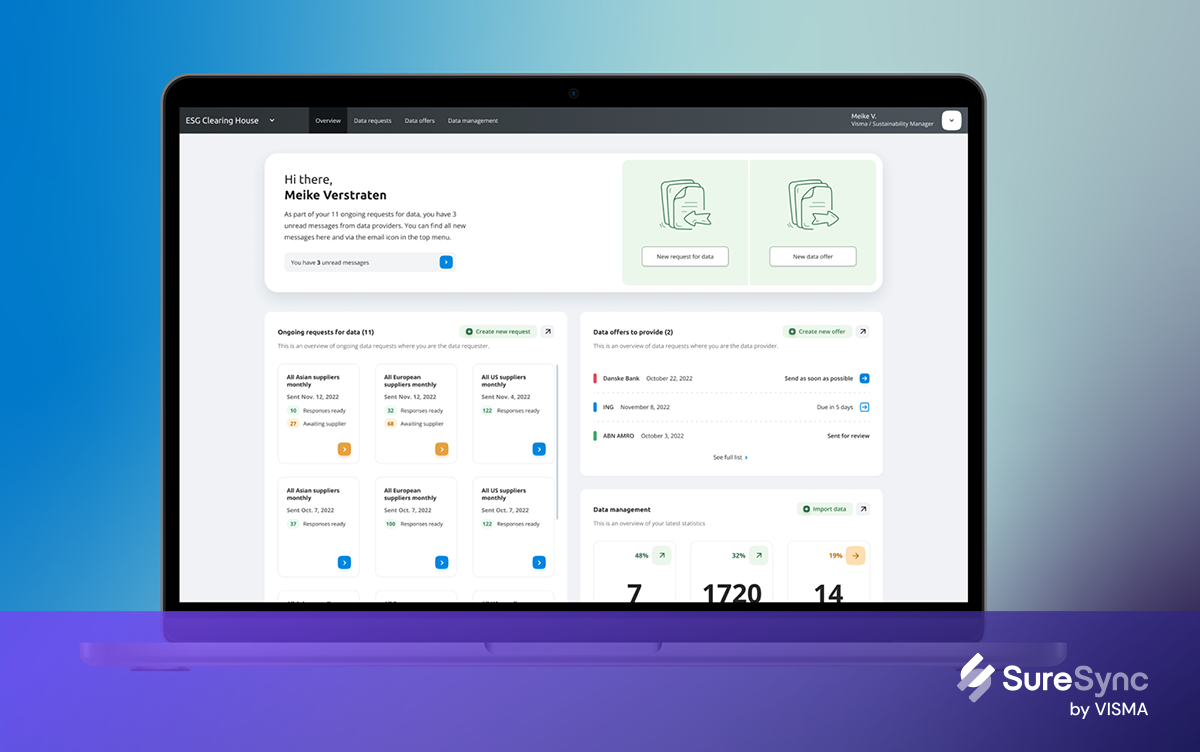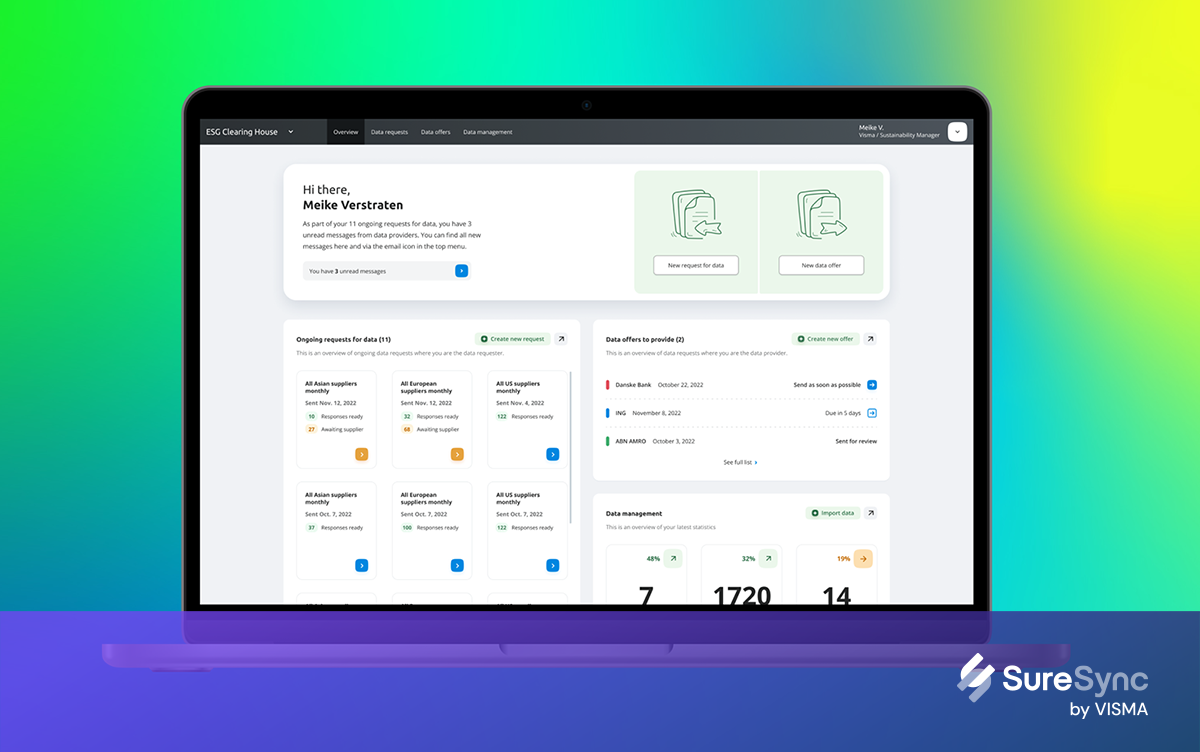What is the ESG Clearing House and how will it transform ESG reporting?
We live in a data-driven world. Data underpins decision-making at every level of government, finance and business and nowadays also sustainability initiatives. Improving sustainability practices and reporting on them requires vast amounts of data. That's why accurate, accessible and standardised data is the gold standard of ESG reporting.
In this blog
- Availability of data
- Why the ESG Clearing House?
- For whom is the ESG Clearing House?
- The need for the ESG Clearing House
- Two important drivers
- Legal requirements and long-term stakeholder value
- How does the ESG Clearing House work?
- Join the ESG Clearing House for future-proof sustainability reporting
Further reading below 👇
Availability of data
However, for many organisations, the availability of all the data necessary to give a complete, transparent and detailed picture of their impact on society isn’t straightforward. Requesting and receiving data from suppliers and business partners is time-consuming; information is often incomplete or of low quality. ESG data collection is time-consuming, error-sensitive, costly, and side-by-side comparisons and benchmarking are tricky.
While standardised frameworks for ESG reporting are underway, standardised data collection is still in its infancy.
That’s why Visma Connect, Signify and ABN AMRO have joined forces to spearhead the ESG Clearing House. An initiative to make ESG data collection and reporting more efficient, collaborative, and accessible for the common good.
Why the ESG Clearing House?
The ESG Clearing House is a market-led, collective solution that enables the standardised exchange of all sustainability metrics, direct and peer-to-peer.
Visma Connect, Signify and ABN AMRO founded the initiative to raise the quality of sustainability data to the same level, quality and timeliness as that of financial data. This is a crucial step towards solving the ESG data challenge - getting high-quality, comprehensive ESG data - many companies face.
For whom is the ESG Clearing House?
The ESG Clearing House is a global, non-profit solution. It enables corporations, supply chain and business partners, capital providers, government agencies and other institutions to exchange ESG data in a standardised format, such as XRBL, through a common and publicly accessible platform.
The ESG Clearing House is the first to unlock peer-to-peer, metric-by-metric ESG data exchange. It uses battle-proven technology to reliably and securely exchange millions of monthly sustainability data transactions.
The ESG Clearing House:
- Provides an open exchange place for both B2B and generic sustainability data in a standardised format
- Acts as a data transaction facilitator for all significant, generally accepted sustainability metrics based on data requests and offers
- Enables straight-through-processing of sustainability data that is eligible for audit
- Is open to any corporate, supplier or capital provider with a global legal entity identification number
- Is open to technical partners who wish to participate, connect and use the ESG Clearing House as an engine in their digital solutions
- Is web 3.0 ready, meaning participants will receive the data when they request it directly from the source
- Uses existing, battle-proven technology with advanced processing capacity designed to handle millions of data exchanges
- Provides a foundation that serves the common good, steered and governed by its participants, for its participants
Join Solving the ESG Data Challenge
ESG Clearing House founders ABN AMRO, Signify, and Visma invite you to join their webinar: Solving the ESG Data Challenge.

In this webinar, we'll explore
- the need for a standardised ESG data exchange
- how to improve ESG data quality: comparable, reliable, complete
- a solution for the collection and exchange of ESG data
The need for the ESG Clearing House
Now it’s clear what the ESG Clearing House is. But why exactly is it needed, and what problems will it solve for participants?
Visma Connect has been working for governments, supervisory authorities and companies since 2006 to ensure secure, correct and timely reporting of their most important and valuable information. As a result, we understand the importance and demand for high-quality, accessible and uniform sustainability data.
Two important drivers
There are two important drivers behind the growing demand for clear, easy, single point-of-access data exchange. The first is the global demand for standardised sustainability metrics by market participants, including capital providers, corporations and supervisory bodies. The second driver is a growing consumer and public awareness of the importance of sustainability in business. This has created business opportunities and a necessity to demonstrate adherence to at least minimal standards of environmental and sustainable business conduct.
Legal requirements and long-term stakeholder value
Next to the growing demand from market participants and consumers, there are more reasons why the demand for ESG data is rising. Legal requirements for sustainability disclosures are increasing at an unprecedented pace, predominantly in Europe and, more recently, the US, the UK, and China. A growing number of companies defines its corporate purpose by focusing on long-term value creation for all stakeholders rather than strictly striving for financial and shareholder value. These companies demonstrate their sustainability values with ESG reporting based on factual data.
Moreover, standardised data exchange will make the lives of corporations and institutions that source their ESG data from suppliers in a slow, costly, inefficient process much easier.
The ESG Clearing House streamlines the ESG data exchange process, allowing companies and other institutions to instantaneous receive the data when they request it straight from the source.
Finally, standardised ESG reporting sends a strong and clear signal to stakeholders and potential investors about companies' ESG commitments. Standardised ESG data is easier to interpret, enabling improved benchmarking and side-by-side comparison.
How does the ESG Clearing House work?
The ESG Clearing House facilitates its participants to submit sustainability data in a standardised XBRL format, allowing users to access the data through an instantaneous exchange. It supports multiple sustainability standards, including GRI and SASB. More will be added as the initiative grows. The project will develop in a collaborative direction and is open to including any sustainability standard to support the universal disclosure and distribution of standardised sustainability data.
The ESG Clearing House is a non-profit organisation overseen by a Board that steers the project's future, providing common access to qualified sustainability data. It will oversee the initiative as it develops, guarantees the project’s objectivity and neutrality, and facilitates adapting multiple standards and metrics.
The initiative addresses the common and urgent need for global standardised sustainability data exchange. Being a non-profit, the ESG Clearing House offers the most effective solution at a fair price at market and user levels. Its non-profit status will substantially increase the widespread acceptance of this initiative.
Join the ESG Clearing House for future-proof sustainability reporting
The initiative's founders, Signify, ABN AMRO, and Visma Connect, want the ESG Clearing House to work for the common good as a non-profit, to serve all members equally and improve the effectiveness and reliability of ESG reporting.
Our core principles:
- Common, inclusive and neutral
- Open partnership, shared benefits, fee-based
- Transaction cost sharing
- Public accountability and transparency
- Entrepreneurial, hands-on and agile approach
- Data preparers will always own their data. The ESG Clearing House will never sell data and is not responsible for its contents.
Though still in its first stages, early registrants to the ESG Clearing House initiative will actively be involved in its development and direction.
Visma Connect, Signify, and ABN AMRO welcome other companies and institutions to cooperate and pilot the ESG Clearing House concept. There are several ways to help us further in this initiative: outreach, communication, public support and funding. The initial supporters get recognition as founders of the ESG Clearing House.
If you want more information about the ESG Clearing House initiative or how your organisation can get involved, you can visit the ESG Clearing House website.




